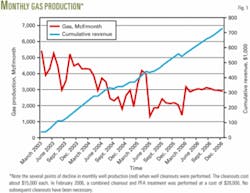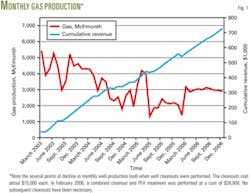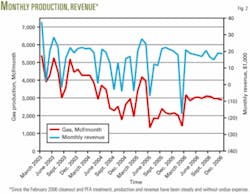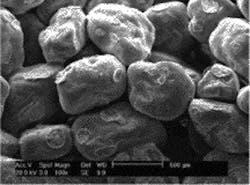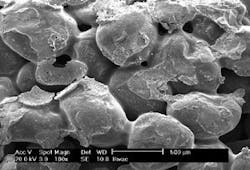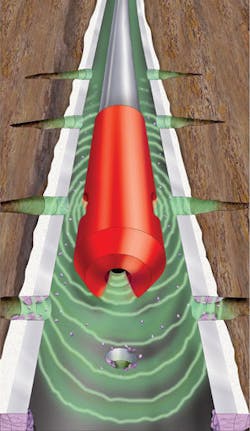In its production operations in northwest Arkansas, XTO Energy Inc. has extended the productive life of five gas wells by controlling proppant flowback. The flowback was plugging rod pump systems and eroding tubular goods.
XTO Energy is the largest natural gas producer in Arkansas, with more than 500,000 acres under lease. The company is following two trends in the Arkoma basin: Fairway trend and Overthrust trend, as well as the Fayetteville Shale. XTO is focusing on well recompletions and new stimulation techniques, as well as drilling additional development wells.
There were three rigs drilling in fourth-quarter 2006 and the company expects to drill 90-100 wells in the Arkoma basin in 2007. About 86% of Arkoma basin production is from Arkansas wells and about 14% from Oklahoma wells (www.xtoenergy.com).
In addition to the five gas wells discussed in this article, XTO has identified many more wells that would likely benefit from flowback control. Projected value added, in the form of reduced workover-cleanout expense and increased production from the five wells treated ranges from $210,000 to 440,000/well/year. Figs. 1 and 2 illustrate the economic impact of conducting cleanout operations to remove produced proppant from the near-wellbore area, tubulars, and production equipment at the surface.
Although flowback-control treatment may have minor effect on production rate in most cases, it helps greatly to keep the wells in continuous production, without requiring shutdown for workover and cleanout processes. In some wells, treatments have increased production substantially.
History
XTO wells in northwest Arkansas were typically drilled and completed in the late 1980s. Completion methods included: (1) perforation and (2) production without fracture stimulation or other production-enhancement measures. The pay zones in these vertical wells are at about 5,000 ft, and they have produced at commercially favorable levels.
In early 2003, XTO accelerated a fracture stimulation program that substantially increased natural gas production. XTO fractured existing producing zones, typically using a nitrified borate gel system to place 20/40-mesh sand. Production spiked up and then began to decline. In addition, proppant flowback accompanying the hydrocarbons fouled the rod-pump system.
In 2006, XTO treated five wells with a proppant-flowback arresting system (Fig. 3) that has (1) halted proppant flowback, (2) prevented damage to the rod-pump systems, and (3) increased productivity. Conventional resin applied to the proppant pack, because of its high viscosity and ineffective displacement, can plug porosity of proppant pack, reducing the flow area available to produce hydrocarbons (Fig. 4).
Arresting flowback
A proppant-flowback arrester (PFA) helps control proppant flowback and fines production and helps maintain highly conductive fractures and long-term productivity. The process is a proven remedy for the fundamental causes of a pervasive industry problem that escalates as production assets mature.
PFA is designed to help slow production decline often seen in fractured wells in mature assets. Proppant flowback and formation fines production cost operators millions of dollars annually in lost production and equipment damage. Wells experiencing these problems require remediation, ranging from routine wellbore cleanouts to complete workovers to expensive artificial-lift equipment repairs. Use of a PFA service addresses the problem with these features:
- Provides cohesion between proppant grains without damaging permeability or conductivity of proppant pack.
- Helps maintain highly conductive fractures and long-term productivity.
- Treats proppant pack with low-viscosity curable resin.
- Applied with pulsing action to enhance uniform placement of treatment fluids into propped intervals.
How PFA is used
PFA service combines new technologies that enable treatment of proppant after it has been placed in the fracture. The service uses coiled tubing coupled with either pressure-pulsing or fluid-wave technology, based on well requirements. PFA service is a coiled-tubing deployed, single-trip, rigless intervention service that requires no isolation packers, thus reducing time, cost, and risk of a conventional workover. This approach treats the existing proppant in the near-wellbore region of propped fractures to reduce or eliminate current and future proppant production and its related problems.
• Consolidating systems. The coating used in PFA service does not produce the high consolidation strength commonly required of a coating in an initial fracturing treatment but is adequate to lock the proppant into place. In addition, the treatment process clears fines and debris from the proppant pack placed near the perforations to help restore and maintain conductivity between fracture and wellbore.
After coating the surfaces of proppant grains, the consolidating agent forms a tacky, thin film of resin that creates bonds between grains that cure with time and temperature. Unconsolidated proppant grains are consolidated with negligible loss of initial permeability.
The combination of resin with the activator into a single component helps ensure that wherever the proppant pack is treated, the consolidation will take place without the uncertainty that often accompanies other consolidation systems. Instead of an instant cure, as often occurs with acid catalysts, curing of the resin designed in this one-component system takes place slowly to allow complete placement into the proppant pack and complete displacement from the pore space within the proppant pack.
• Pulsing tools. PFA treatments can be applied with either fluid-oscillator technology or low-frequency pulsing; both methods enhance fluid flow through porous media (Fig. 5). Fluid oscillation produces emissions of alternating bursts of fluid that create pulsing pressure waves within the wellbore and formation fluids. These pressure waves can break up many types of near-wellbore damage, helping restore and enhance the permeability of the perforations and near-wellbore area.
Wave stimulation is a coiled-tubing deployed placement method for improving chemical treatments such as matrix acidizing, scale inhibition, and remedial sand-proppant control. The wave technology is based on high-amplitude, low-frequency pulsing (LFP) to enhance flow of fluids through porous media.
Its porosity-dilation effect results in fluids being forced into normally unoccupied pore spaces under the influence of pressure waves. The effect is more attributable to fluid-wave propagation and pore dilation than to rock movement.
PFA service provides the following technical and economic benefits:
- Extends production life of the well.
- Reduces proppant production.
- Reduces wear on surface equipment and tubulars.
- Reduces need for workovers and well cleanouts.
- Reduces damage to artificial-lift equipment.
- Can be placed into existing proppant packs.
PFA service procedure
PFA treatments applied to five wells are described below. Procedures followed on two wells are detailed; similar procedures were followed for all five wells.
Case 1
This well was identified for treatment because it required cleanout to remove proppant every 3 months, requiring a workover rig. The source of the proppant was a fracture treatment performed in 2003 to increase production that had declined to marginal levels. Typical cleanout costs are $3,000/day for the workover rig, with 4 lost-production days associated with the process. Cleanout costs range between $18,000 and $44,000.
The PFA treatment was performed on two zones, both on the same day, in 6 hr of pumping. Between proppant-conditioning flushes and chemical spacers, 75-gal batches of resin were pumped down 2 3/8-in. jointed tubing with a local workover rig to reciprocate the tubing across each perforated interval.
A pulse-pressure tool was applied across the perforated intervals to enhance fluid flow into the proppant porosity. The pulsing technique eliminated the need for mechanical isolation between intervals. Pumping rate was 1 bbl/min. No proppant flowback has been observed during the year of production since the treatment.
Case 2
This well was completed in 1986 and produced naturally until 2003, when it was fractured with a borate-cross linked gel and 75,000 lb of 20/40 white sand, at 1 to 5 lb/gal. Initial proppant-sand production reduced rod-pump system efficiencies, leading to costly workover completions and nonproductive time.
The PFA treatment was conducted in much the same manner as described in Case 1. Since the treatment, no proppant has been produced and the pumping system continues to run smoothly. Economically viable production levels have been restored.
The authors
Al Hood ([email protected]) is a senior production engineer with XTO Energy in Oklahoma City. He has held various engineering and management positions in the oil and gas industry for more than 29 years. Hood is currently involved in completion and production operations in the Arkoma basin. He holds a BS in chemical engineering from the University of Arkansas.
Stephen Ingram ([email protected]) is a technical advisor to the US Midcontinent for Halliburton Energy Services, Oklahoma City. He previously worked for NANA Corp. managing environmental projects at Prudhoe Bay oil field. Ingram holds a BS in chemical engineering from the University of Missouri at Rolla.
Joseph Blakey ([email protected]) is a senior account representative within the Halliburton business development group in Oklahoma City. He has 16 years with Halliburton, where he has held various engineering and technical sales positions. Blakey is involved with new well completions as well as remedial completions, focusing primarily on production enhancement and cementing solutions. He graduated with a BS (1990) in mechanical engineering from Colorado State University.
Philip Nguyen ([email protected]) is a technical advisor in technology with the production enhancement group at the Halliburton Technology Center in Duncan, Okla. He has more than 17 years with the oil and gas industry. Nguyen’s current work focuses on research, development, and applications of curable and noncurable resins for hydraulic fracturing and sand control. He holds a PhD in chemical engineering from the University of Oklahoma.
